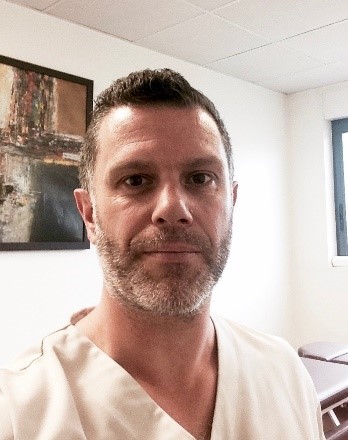
Grégoire Ferré, osteopath
“The right diet considerably reduces the risk of muscle, tendon and joint injuries”
What is the purpose of medical supervision when preparing for a sports event?
For an event like the Diagonale des Fous, it is mainly preventive. The aim will be to get to know the athlete inside-out, to get an accurate “picture” of them and act accordingly by adapting the training sessions to avoid injuries.
Supervision begins with a checkup by a sports physician:
- Biometrics (weight, height and body fat)
- Cardiology (blood pressure, heart rate, pulse reading, stress test, etc.)
- Lungs (inspection, auscultation)
- Digestive system
- Neurological system (disorders affecting the senses, motor system, reflexes, etc.)
- Teeth
- Eyesight (visual acuity, perception of depth)
- Hearing
- Joints: inspection, palpation and mobilisation
- Muscular disorders: deficit, amyotrophy
- Suppleness: flexibility testing of hamstrings, quadriceps, adductor muscles, etc.
The osteopathy assessment will look for any structural abnormalities which could become more pronounced through intense, repetitive strain. The aim is to correct any disorders or imbalances, and any bone, joint, ligament or muscle lesions at an early stage, before they lead to more serious injury.
Medical supervision of athletes also includes nutrition and diet.
The purpose of supervision is to detect microtraumatic lesions caused by overworking the body: stress fractures, tendinopathies, muscle injuries, etc. It is also designed to pick up on potential overtraining which can result in prolonged fatigue characterised by a drop in performance.
In your view, how does poor nutritional preparation impact on an athlete’s physique?
There is a need to explain dietetics to athletes. Diet has become a real factor in terms of performance and should be tailored to each individual. We need to analyse the meals of every athlete over the week, to detect any errors or inconsistencies that could have serious consequences on the athlete’s physical condition.
This is a job for nutritionists and dieticians. They will give the athlete broad dietary guidelines: the four meals, when to take on board carbohydrates, protein and fat, hydration, and fuelling before, during and after races. They will also provide information on food and vitamin supplements.
It is clear that the right diet reduces the risk of muscle, tendon and joint injuries considerably.
As I often say, having the right diet does not mean you will win, but having the wrong diet means you will definitely lose!
What are the most common injuries for a trail/ultra-trail runner? And what are the main causes?
There are five of them.
-
Tendinitis: inflammation of the tendon (especially the Achilles, patellar and quadriceps tendons), mostly felt during exertion and easing with rest. This inflammation can become a regular occurrence over time and, in certain cases, become chronic.
-
Iliotibial band syndrome: inflammation of the outside of the knee caused by the continual rubbing of the ITB (the thick band of fascia that connects the outside of the knee to the outside of the pelvis) combined with repeated flexion and extension of the knee.
-
Plantar fasciitis (jogger’s heel): inflammation of the tendons and ligaments between the heel and the toes, resulting in soreness in the ball of the foot or under the heel. This is the most common foot injury among runners.
-
Pulled muscle/ligament: overstretching of a muscle or a ligament resulting in limitation of sporting activity. This may be a precursor to a strain or tear.
-
Tibial periositis (shin splints): inflammation of the surface layer of the bone.
The main causes of these injuries, and others that unfortunately cannot be excluded, are:
- Overtraining
- An inadequate or unbalanced diet
- Inadequate warmup with little or no stretching
- Muscular deficit (not enough strength training, such as core stability exercises, squats, etc.)
- Unsuitable shoes
- Lack of specific medical supervision: physician, osteopath, physio, nutritionist, etc.
What do you recommend in terms of osteopathic supervision (number of sessions and types of exercise) for regular trail/ultra-trail runners?
At the risk of repeating myself, I recommend:
- At least three sessions a year with an osteopath.
- A nutritional and medical checkup at least once a year (do not underestimate the importance of a dental check as the occlusive system is closely related to posturology).
- Cross training – such as swimming or cycling – where possible.
- Not forgetting specific muscle exercises such as core stability, squats, etc.
- And, last but not least, regular periods of REST are essential as they allow the body to regenerate. Rest is a treatment in its own right. It helps athletes to replenish their energy reserves, recover from the effects of training and competition, and avoid overtraining and the subsequent risk of injury.
Do you also run? Which sports have you played?
After trying many sports (football, gymnastics, athletics and rugby), I found I really liked volleyball and went on to complete a three-year sport-study programme. I now go running twice a week and play tennis for two hours a week.
MID-TERM ASSESSMENT
 Grégoire FERRE, osteopath
Grégoire FERRE, osteopath
I’m in contact with Morgane and Nicolas about once a fortnight. They are motivated and highly dedicated. They are of course getting quality support but they follow our advice diligently. However, they are putting a lot of pressure on themselves. There is still some way to go before they set off, and they must not forget to enjoy what they’re doing, particularly during this period where they have picked up minor injuries. We are not worried from a physical point of view, but a year’s preparation for such a challenge really is necessary. You can’t leave anything to chance with this kind of event. Often runners do not realise how important diet and physical preparation are. It’s not just about running for months on end. Morgane and Nicolas were in fact surprised that the first months of training consisted essentially of core stabilisation work and muscle strengthening.